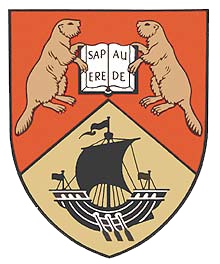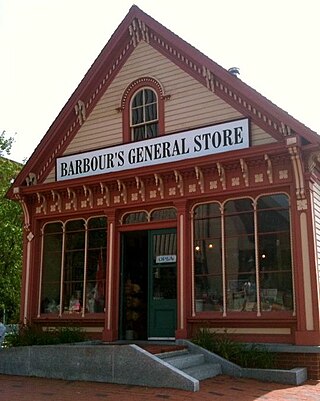
Fredericton is the capital city of the Canadian province of New Brunswick. The city is situated in the west-central portion of the province along the Saint John River, also known by its Indigenous name of Wolastoq, which flows west to east as it bisects the city. The river is the dominant natural feature of the area. One of the main urban centres in New Brunswick, the city had a population of 63,116 and a metropolitan population of 108,610 in the 2021 Canadian Census. It is the third-largest city in the province after Moncton and Saint John.

Saint John is a seaport city located on the Bay of Fundy in the province of New Brunswick, Canada. It is Canada's oldest incorporated city, established by royal charter on May 18, 1785, during the reign of George III. The port is Canada's third-largest by tonnage with a cargo base that includes dry and liquid bulk, break bulk, containers, and cruise. The city was the most populous in New Brunswick until the 2016 census, when it was overtaken by Moncton. It is currently the second-largest city in the province, with a population of 69,895 over an area of 315.59 km2 (121.85 sq mi).

The University of New Brunswick (UNB) is a public university with two primary campuses in Fredericton and Saint John, New Brunswick. It is the oldest English-language university in Canada, and among the oldest public universities in North America. UNB was founded by a group of seven Loyalists who left the United States after the American Revolution.

The University of Prince Edward Island (UPEI) is a public university in Charlottetown, Prince Edward Island, Canada, and the only university in the province. Founded in 1969, the enabling legislation is the University Act, R.S.P.E.I 2000.

Sackville is a former town in southeastern New Brunswick, Canada. It held town status prior to 2023 and is now part of the town of Tantramar.

Sutton Coldfield or the Royal Town of Sutton Coldfield, known locally as Sutton ( ), is a town and civil parish in the City of Birmingham, West Midlands, England. The town lies around 8 miles northeast of Birmingham city centre, 9 miles south of Lichfield, 7 miles southwest of Tamworth and 7 miles east of Walsall.

Woodstock is a town in Carleton County, New Brunswick, Canada on the Saint John River, 103 km upriver from Fredericton at the mouth of the Meduxnekeag River. It is near the Canada–United States border and Houlton, Maine and the intersection of Interstate 95 and the Trans-Canada Highway making it a transportation hub. It is also a service centre for the potato industry and for more than 26,000 people in the nearby communities of Hartland, Florenceville-Bristol, Centreville, Bath and Lakeland Ridges for shopping, employment and entertainment.

The Université de Moncton is a Canadian francophone university in New Brunswick. It includes campuses in Edmundston, Moncton, and Shippagan.

Sussex is a town in Kings County, New Brunswick, Canada. Sussex is located in south central New Brunswick, between the province's three largest cities, Saint John, Moncton, and Fredericton.

William Francis Ganong, M.A., Ph.D., LL.D., F.R.S.C., was a Canadian biologist botanist, historian and cartographer. His botany career was spent mainly as a professor at Smith College in Northampton, Massachusetts. In his private life he contributed to the historical and geographical understanding of his native New Brunswick.

The Hartland Covered Bridge in Hartland, New Brunswick, is the world's longest covered bridge, at 1,282 feet (391 m) long. It crosses the Saint John River from Hartland to Somerville, New Brunswick, Canada. The framework consists of seven small Howe Truss bridges joined on six piers.

Edwardian architecture usually means a Neo-Baroque architectural style that was popular for public buildings in the British Empire during the Edwardian era (1901–1910). Architecture up to 1914 is commonly included in this style.

The University of Wales Trinity Saint David is a multi-campus university with three main campuses in South West Wales, in Carmarthen, Lampeter and Swansea, a fourth campus in London, England, and learning centres in Cardiff, Wales, and Birmingham, England.

Fanshawe Pioneer Village is an open-air museum established in 1959 and located in the Fanshawe Conservation Area in London, Ontario. The village uses historical re-enactments to communicate the history of rural communities in the former townships of Westminster, London, North Dorchester, Delaware, West Nissouri and Lobo in Middlesex County from 1820 to 1920 and the founding and development of the City of London up to 1840.

Barbour's General Store was a museum and tourist hub in Saint John, New Brunswick. It was an authentic 19th-century general store building, preserved and used to recreate a Victorian-era educational experience for visitors. It was located at the intersection of King Street and Prince William Street just outside the Trinity Royal Historic Conservation Area in the city's uptown. On August 22, 2015 the shop was re-opened to the public as a functioning business and local information centre. On June 13, 2023 the building was proposed to demolish after a fire in January 2022. It was dismantled in July 2023.

The Trinity Royal Heritage Conservation Area is a historic district in Saint John, New Brunswick's uptown. The City of Saint John designated the area as the city's first heritage conservation area in 1982; it has since expanded in area. Surrounding the Trinity Anglican Church, the area includes several National Historic Sites of Canada within its boundaries. Much of the area consists of Victorian brick buildings raised after The Great Fire of Saint John, New Brunswick that destroyed much of the city's central peninsula in 1877.

The history of Saint John, New Brunswick is one that extends back thousands of years, with the area being inhabited by the Maliseet and Miꞌkmaq First Nations prior to the arrival of European colonists. During the 17th century, a French settlement was established in Saint John. During the Acadian Civil War, Saint John served as the seat for the administration under Charles de Saint-Étienne de la Tour. The French position in Saint John was abandoned in 1755, with British forces taking over the area shortly afterwards.

The Domville Building is a historic bank branch in Saint John, New Brunswick. Operated by the Bank of Montreal as one of its current branches, it is located on 2 King Street, at the southeast corner of King and Prince William Streets. Built in 1878 and used by the Bank of Montreal since its completion, it is a Second Empire style structure built using sandstone. The Domville Building is located within the Trinity Royal Heritage Conservation Area.



















